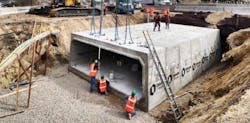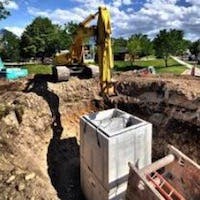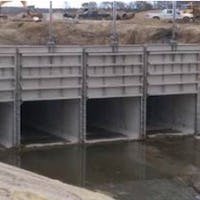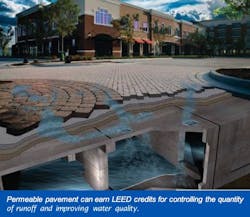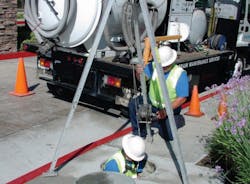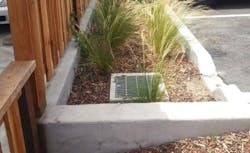Stormwater Management Guide
A look at the methods behind stormwater runoff control and pollutant reduction.
Introduction
Designing a project site to maintain its normal stormwater flows and reduce pollutants after development is essential. The right plan prevents flooding, habitat degradation, erosion, and pollution in our waterways. Whether your project is a re-development, new development, or an urban retrofit, there are a variety of tools and techniques that can be used to meet water protection programs and regulations.
The recommended best management practices (BMPs) for stormwater runoff are to treat rain water where it falls. The three criteria used to accomplish this are:
Volume: Reduce or delay the volume of stormwater that enters the sewer system.
Peak Discharge: Reduce the maximum flow rate into the combined system by decreasing the stormwater volume and lengthening the duration of discharge. This inherently lowers the frequency of combined sewer overflows.
Water Quality: Improve water quality through pollutant reduction, using filtering and biological and chemical processes.
This guide highlights the methods behind stormwater runoff volume control, pollutant reduction, and maintenance, allowing you to:
Meet Regulatory Permitting Requirements.
Each municipality has its own set of minimum BMPs for residential, industrial, and commercial activities that impact stormwater runoff.
The National Pollutant Discharge Elimination System (NPDES) was created by the Clean Water Act in 1972 and enables smaller governments to perform the permitting, administrative, and enforcement aspects of the program.
Operators who do not meet permitting requirements can be held legally responsible for not complying with their requirements.
Meet Low Impact Development (LID) Requirements.
According to the EPA, LIDs are a variety of systems and practices that use natural processes to protect water quality and associated habitats.
With regards to stormwater, LID uses nature to manage stormwater as close to its source as possible and maintain a watershed’s hydrologic functions.
Examples include designing sites to minimize land disturbance, using vegetated swales, permeable pavement, and rainwater harvesting.
Earn Points Toward LEED Credits.
The U.S. Green Building Council (USGBC)’s Leadership in Energy and Environmental Design (LEED) rating system allows projects to pursue certification and earn points across several categories.
While there are several stormwater-oriented credentials available to earn, the overall intent of them is to minimize disruption to the natural hydrology of the site and to reduce pollutants.
Stormwater
Runoff Volume Reduction
A key to preventing habitat degradation and erosion of local channels is controlling runoff volume from developed sites. Whether the rain is falling on the streets, a parking lot, or roofs, the water is unable to soak into the ground and follow its natural path to the water table or streams. Capturing and controlling release of runoff can avoid problems and allow for groundwater recharge and replenishment of local aquifers.
An alternative to a controlled release of water back into the ground is harvesting the stormwater – along with greywater – and reusing it for landscape irrigation, toilet flushing, and cooling towers, among other things. Such solutions can help meet project or jurisdictional LID requirements or can help earn points towards LEED credits.
Controlling stormwater runoff can help reduce water pollution, drought, and public health concerns, causing stormwater management solutions to become even more critical as part of the site design. Below we look at solutions that can help manage stormwater runoff.
BIM and GIS
Building information modeling (BIM) and geographic information systems (GIS) planning tools support the design of LID features, such as swales, rain gardens, and pervious pavement. These tools provide new stormwater management options for the development community and will assist with site planning, facility design, and engineering method selection.
Infiltration Trenches
Infiltration trenches are excavated trenches filled with aggregate that collect runoff during a storm and release it into the soil. According to the EPA, however, their use is restricted by concerns about potential groundwater contamination and clogging if not properly maintained. Each state provides a stormwater manual or specific infiltration trench requirements, which you should consult in the planning process.
Underground Storage
On-site tanks that are placed underground collect stormwater runoff and control volume. The stored water can be detained and released at a controlled rate into local aquifers or the sewer. Depending on regulatory requirements, the stored water can also infiltrate back into the groundwater supply or be retained and reused for harvesting applications. Underground storage tanks can also have treatment solutions that addresses water quality issues for varying jurisdictions.
Permeable Pavement and Concrete Systems
Permeable pavement rapidly allows drainage of stormwater off streets, parking surfaces, driveways, and more. Water passes through a layer of permeable concrete, followed by an aggregate sub-base over undisturbed soil. In some cases, the water runs freely to the underlying ground below. In other situations, a reservoir stores the runoff temporarily before allowing it to infiltrate into the soil. While the appearance is very similar to traditional concrete or asphalt, permeable pavement is made without fine materials. It incorporates void spaces that allow water to pass through for storage and infiltration into the soil.
Permeable Pavers
Pavement that is impervious to water is the primary source of runoff. Permeable pavers are an ideal way to accommodate precipitation and promote infiltration. Such pavers are made from a system of varying sized aggregate underneath that filter and direct water to local groundwater supplies. By creating voids between the pavers, precipitation has access to the soil for infiltration. Permeable pavers can be used for primary parking, overflow parking, walkways, plazas, driveways, and patios. Using permeable pavers with a stormwater storage facility below grade can provide a more complete LID system that keeps runoff on the site and allows for harvesting as needed.
Green Roofs
Vegetation on “green” roofs allows for infiltration and evapotranspiration of stored water. According to Green Roofs for Healthy Cities, the amount of water retention varies by season, as well as the depth of the growing medium and the number of plants. Instead of running off, the substrate captures the rain water allowing the plants to utilize it, subsequently returning it to the atmosphere through evaporation and transpiration. If runoff does occur, the vegetated roof operates as a natural filter. A green roof also moderates the flow of any runoff into the sewer system helping to prevent system overloads. Depending on the design and integration, green roofs can contribute to credits in the LEED rating system for the following categories: Sustainable sites, materials resources, water efficiency, and more. However, such systems may require different structural requirements for live and dead loads, so the appropriate assessment must be completed.
Pollutant
Reduction
When building the infrastructure that helps with increased urbanization, we want minimal impact on the surrounding environment. The volume of runoff created from sprawling communities is hard to avoid, but manageable. As are the methods we use to reduce pollutants. As the number of vehicles on our roadways climbs and the number of people grows, the amount of pollutants that accumulate must be addressed. Developers have a responsibility to do so. The size and type of pollutants that come off of our paved streets, parking lots, and rooftops include sediment, metals, nutrients, petroleum hydrocarbons (oil and grease), trash and more that can affect wildlife and habitats downstream. Below we look at types of pollutant filtration and reduction systems.
Inlet filtration and trash capture
Stormwater is one of the biggest sources of pollutants as it can pick up a variety of contaminants in many sizes. Filters and guards capture course sediment, trash, total suspended solids (TSS), and petroleum hydrocarbons. These devices are located where the water is first captured as they trap the largest debris that stormwater picks up.
Hydrodynamic separation
Hydrodynamic separators also remove trash and debris along with sediment and oils. They allow stormwater to flow-through the unit during high flows while capturing pollutants in a settling or separation unit. Through the use of vortex cylinders, settled particles are collected in the isolated bottom storage compartment, minimizing re-suspension, while floating debris and oils are retained in the upper storage areas. They can be used alone or in conjunction with other stormwater management devices as a pre-treatment.
Media filtration
Media filtration systems capture and retain sediment, TSS, oil and grease, phosphorus, metals, and more. They use a mix of media often contained in cartridges to remove the smaller pollutants. These devices often have pre- treatment chambers and replaceable cartridge filters that help reduce the total downstream pollutant discharge load in stormwater runoff.
Bioretention and biofiltration
A great solution for LID requirements are bioretention and biofiltration. These processes remove contaminants and sediment from stormwater runoff through the use natural products such as filtered soils, vegetation, aggregates and mulch.
System
Maintenance
Having volume and pollutant reduction in place isn’t always enough to meet regulations, LID requirements, or earn LEED credits. Often, Federal, State and Local jurisdictions require installed stormwater management systems to be properly maintained and serviced on a regular basis. Property owners can be subject to expensive fines if the systems are not maintained properly and regularly. In fact, the main causes of stormwater management failure are inadequate maintenance, functional failure, and structural failure. Catch basin filtration systems, stormwater interceptors, and other runoff collection structures should be examined by confined-space certified technicians. Collected materials should be disposed of per local regulations to ensure that harmful contaminants are removed properly.
Conclusion
Whether you are designing a new development, a re-development or an urban retrofit, knowing what methods and techniques are available to meet stormwater regulations is essential. If you use some of the previous best management practices and work within the landscape, focus on prevention, and keep it simple, you will be closer to meeting your LID requirements and earning LEED credits. Stormwater Management Guide Page 9
